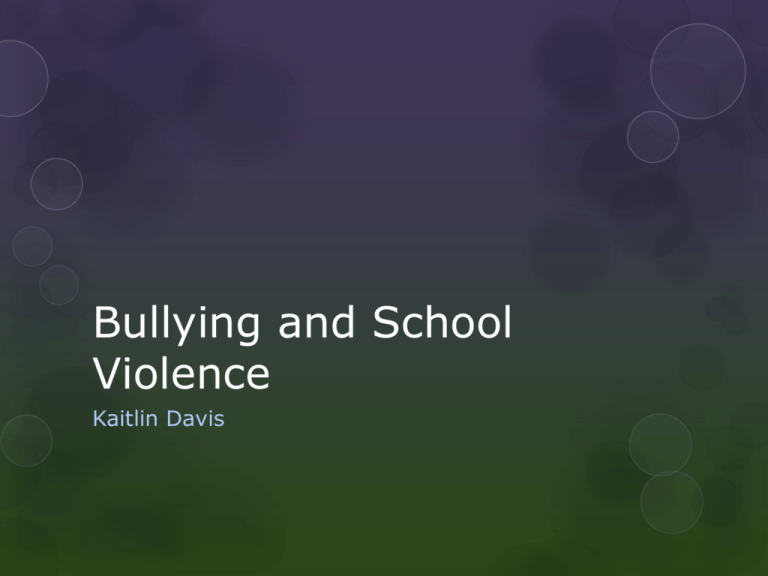File
advertisement

Bullying and School Violence Kaitlin Davis Agenda Introduction Root of violence School Counselor role Data and assessment Response: Laws, ethics, and procedures Prevention Best Practices Examples Problem Tree Sources of Power Gender Delegated authority Social class Resource currency (Money, food, property) Personal or group charisma Ascribed power (acting on perceived or assumed abilities) Expertise (ability, skills) Persuasion Knowledge (granted or witheld) Celebrity Force (violence, military might, coercion) Moral persuasion (i.e. religion) Operation or manipulation of group dynamics (i.e. public relations) Tradition Domination/submission Types of Violence Bullying/Cyber Harassment Intimidation Institutionalized racism and sexism Micro-aggressions Sexual harassment Hate crimes Sexual Assault Dating violence Witnessing domestic violence Gang violence Racial/ethnic discrimination “Violence is anything that denies human integrity and leads to hopelessness and helplessness.” ~Martin Luther King, Jr. Impact Feeling Powerless Internalized Externalized Trauma Development Academics Attendance Feeling emotionally and physically unsafe Contribute to mental illness Trends Rising concern, but decreasing rates Overall crime rate 1993-1997 155 crimes/1,000 students Fewer injuries due to violence, fewer weapons and physical fights on school grounds (U.S. Department of Education, 1999) 12-18 more likely to be victims away from school (National Center for Education Statistics, 2000) “Typical” trend of adolescent violence: inner-city, clear dispute, low SES, economic, territorial, or retaliation motive (McWhirter, 2004) “Atypical” school shootings: suburbs, small towns, rural areas, affluent, intact families, academically capable, White (McWhirter, 2004) Students do not feel safe at school (37% don’t feel safe, 45% avoided school grounds, and 43% avoided rest rooms, 20% avoided hallways. School Counselor Role Federal Law: The No Child Left Behind (NCLB) Act of 2001 requires states to address bullying Safe and drug free schools funding State Law: WAC Prohibits HIB District primary contact Liaison with Educational Ombuds ACA/ASCA Ethics Code OSPI: Safety Center Food for thought What types of violence do you see in your internship site? What is the role of the school counselor at your site? Bullying--Definition Victims are exposed repeatedly and over time From one or more other students Intent to distress or harm the victim Power imbalance often exists (physical or social) Negative actions can range from nonverbal (ie, ostracism) to overt (ie, punching, throwing objects, vandalism). (Olweus as cited in Blosnich & Bossarte, 2011) Bullying--Prevalence % Whatcom County youth bullied in the last 30 days (Healthy Youth Survey, 2008). 16% of 12th grade 23% of 10th grade 27% of 8th grade 27% of 6th grade % U.S. public schools who reported experiencing at least one bullying incident per week (National Center for Education Statistics, 2004). 24% of Primary 42% of Middle 21% of High School Bullying Prevention Programs Two Types Curriculum (i.e. Responding in Peaceful and Positive Ways) Statistically significant results, especially provocation and physical Small effect size, not maintained Whole-school: (i.e. Positive Behavior Support) School-based programs can be effective (20%-50% reduction in reports) Variations in the effects of different programs. Olweus-inspired programs most effective http://www.olweus.org/public/testimonials.page High quality instruction! Strategies that do not work Social skills training for victims Peer mediation (poorly designed) “0 Tolerance” discipline policies Safety measures (on their own) Using Multi-media for Prevention: Social Norms Campaigns: R.E.S.P.E.C.T Video: http://www.youtube.com/watch?v=iGuT9-_Y5J4 Video Memoirs Not In Our Town student empowerment http://www.niot.org/nios-video/students-takecyberbullying Songs and poems for discussion http://www.youtube.com/watch?v=lgT1AidzRWM http://www.youtube.com/watch?v=VdUBjFeWxfU Educating Parents Monitoring Know and look for (including internet) warning signs Established family rules Rights and responsibilities Filtering/blocking media Searches Offer training Cyber safety program at www.netsmartz.org Working with Aggression Youth aggression is ecological and developmental (64% of school counselors did not know this) Individual variables School variables Roots in family structure: child-leadership, lack of parental modeling, direction, and support, strict boundaries, family violence and threats Reactive (escalation): Counseling at triggering, escalation, and post-crisis stage, NOT crisis stage or recovery stage—use firm direction. Proactive aggression (McAdams, Shillingford, and Trice-Black, 2011) Addressing Risk for Persistent Offending Risk factors (ages 8-18) that predicted persistance after age 21: (Longitudinal, n=411, London, Males) Heavy drinking at age 18 Hyperactivity at ages 12-14 Low popularity and harsh discipline at ages 8-10 Risk factors that predicted non-offenders would onset after 18 were: Poor housing ages 8-10 Low nonverbal IQ ages 8-10 High neuroticism at age 16 Anti-establishment attitudes and motoring convictions at 18 Student Monitoring Having adults and/or staff supervising hallways associated with lower reports Cameras/security guards not as effective as teachers Difficult to determine effectiveness because schools using safety measures, such as cameras, may already be experiencing higher levels of bullying Coaching Executive Functions Initiation: organizing thoughts well enough to get started on a task Flexibility: Shifting focus and pace as situations unfold Attention: Focusing long enough and accurately enough to learn important information. Also, blocking distraction and discerning priorities. Organization: Managing space—a chaotic environment has an emotional impact! Planning: Managing time, finishing things on time Working memory: Retaining information long enough for it to be stored long-term key for learning and for other other executive functions Self-awareness: Sufficient self-knowledge and understanding of how one is seen by others. Key for making purposeful choices about how to act in situations where one wants to avoid unintended consequences that lead to isolation or ostracism. Managing emotions: Expressing feelings in proportion (silent recluse vs. erupting volcano.) Key Messages To offenders: NOT OK!, CAUSES REAL HARM, REAL CONSEQUENCES To victim: NOT YOUR FAULT!, YOU ARE NOT POWERLESS To bystanders: STAND UP!, LISTEN To families: BE AN ALLY and ROLE MODEL, SUPERVISE To schools and communities: PROVIDE SAFE SPACE, TAKE VIOLENCE SERIOUSLY, ALL FORMS, ALL VICTIMS, ALL OFFENDERS To global citizens: WE ARE INTERCONNECTED, WE ARE NOT OUR STEREOTYPES To allies: THANK YOU!






